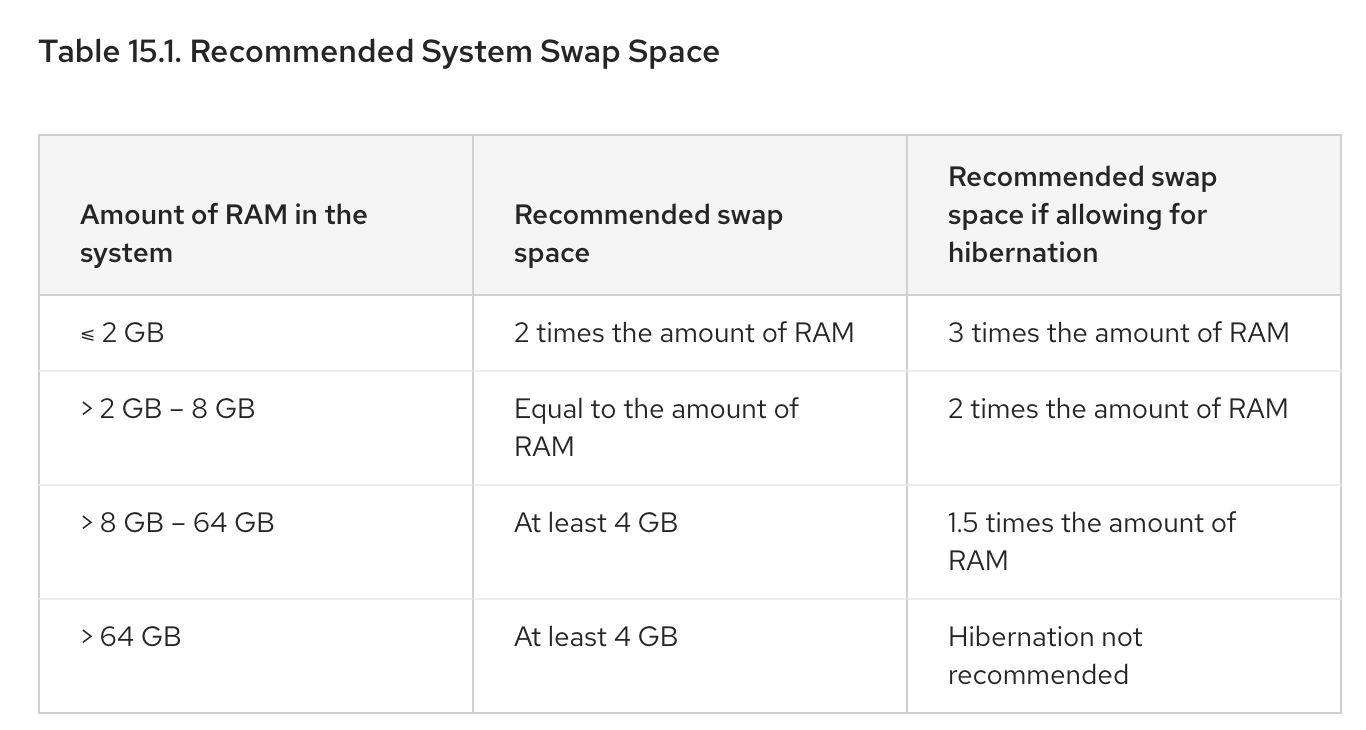SWAP常见问题分析和性能调优配置实践小结
前言
SWAP内存交换分区对大家来说是一个经常被忽视的细节,如果大家对SWAP配置不是很熟悉可以参考文章内提到的Red Hat SWAP SPACE最佳实践配置链接。本文主要分享SWAP的基础知识和优化建议,以及如何使用ansible优雅的关闭和增加SWAP交换分区等实践心得。
更新历史
2020年04月27日 - 初稿
阅读原文 - https://wsgzao.github.io/post/swap/
Red Hat SWAP SPACE
Red Hat官方给出的配置建议已经很详细了,我不再做多余介绍
Swap space in Linux is used when the amount of physical memory (RAM) is full. If the system needs more memory resources and the RAM is full, inactive pages in memory are moved to the swap space. While swap space can help machines with a small amount of RAM, it should not be considered a replacement for more RAM. Swap space is located on hard drives, which have a slower access time than physical memory. Swap space can be a dedicated swap partition (recommended), a swap file, or a combination of swap partitions and swap files. Note that Btrfs does not support swap space.
In years past, the recommended amount of swap space increased linearly with the amount of RAM in the system. However, modern systems often include hundreds of gigabytes of RAM. As a consequence, recommended swap space is considered a function of system memory workload, not system memory.
m Swap Space” illustrates the recommended size of a swap partition depending on the amount of RAM in your system and whether you want sufficient memory for your system to hibernate. The recommended swap partition size is established automatically during installation. To allow for hibernation, however, you need to edit the swap space in the custom partitioning stage.
Recommendations in Table 15.1, “Recommended System Swap Space” are especially important on systems with low memory (1 GB and less). Failure to allocate sufficient swap space on these systems can cause issues such as instability or even render the installed system unbootable.

At the border between each range listed in Table 15.1, “Recommended System Swap Space”, for example a system with 2 GB, 8 GB, or 64 GB of system RAM, discretion can be exercised with regard to chosen swap space and hibernation support. If your system resources allow for it, increasing the swap space may lead to better performance. A swap space of at least 100 GB is recommended for systems with over 140 logical processors or over 3 TB of RAM.
Note that distributing swap space over multiple storage devices also improves swap space performance, particularly on systems with fast drives, controllers, and interfaces.
SWAP预备知识
什么是swap
swap当我们指的名词的时候,它可以是一个分区,也可以是一个文件,是操作系统中一个存放从内存中置换出的数据的地方。
当我们指的是一个动词时候,代表的是从物理内存交换数据到swap分区这个动作。
为什么会swap
- 当物理内存不够用时候,会根据特定的算法,把一部分内存交换到swap分区(此时还会伴随着高IO)。但是并不是所有的内存都可以被交换到swap分区。
- kswapd进程周期性对内存进行检查,如果发现高于水位线,则触发swap,此举是为了不让系统剩余内存很少,防止出现突然的大内存申请。这块暂不深入讲解,后续再补充。
swap的到底是什么
首先我们要知道,内存管理将内存分为active和inactive,进程用户空间使用的映射包括了匿名映射(anon)和文件映射(file)。所有一共有active anon,inactive anon,active file,inactive file。对于文件映射,由于本身是磁盘空间中的文件,所有它不会被swap,当需要释放时候,脏数据直接写回磁盘,其他数据直接释放即可。内存交换到swap,肯定是交换不活跃的数据,所有,inactive anon是最主要的被交换的内存。那么对于操作系统来说,当我需要回收内存时候,你说它是针对文件映射好,还是针对匿名映射好,这就涉及到了一个参数:swapiness
swapiness
swapiness是设置内存回收时候,更倾向于回收文件映射还是匿名映射,在/proc/sys/vm/swappiness设置值。对于swapiness=100,那么两者之间的权重是一致的,值越小,越倾向于回收文件映射,不过如果达到系统高水位线,还是会swap,除非直接使用swapoff -a等手段关闭系统swap。
swap的好坏
swap的好处是当内存不足时候,可以将一部分交换出去,不会触发oom-killer。跑得慢总比不能跑好。
swap的坏处是交换时候,会触发高IO,同时会降低系统的性能。对于我们隔离做的不好的时候,会影响到其他应用的性能。
swap查看方法
一个工具往往具有多种用途,但是本文只说明针对swap问题
| 工具名称 | 使用姿势 | 采集指标来源 |
|---|---|---|
| free | free -h | /proc/meminfo |
| top | 按f,选择swap | /proc/$pid/smaps |
| vmstat | vmstat | /proc/meminfo |
| iotop | iotop | |
| iostat | iostat -xdm | |
| pidstat | pidstat -d 1 | /proc/$pid/io |
1 | # 通过此命令查看内存被哪些进程占用(单位是MByte) |
常见的swap优化思路
以K8s为代表的容器编排已经给出了比较简单粗暴的分类
- 有状态(Stateful)
- 无状态(Stateless)
针对有状态的服务比如Database数据库,Cache缓存等,为了减少核心服务出现Out of Memory(OOM)的情况,合理的使用swap并做好监控是非常有必要的。
针对无状态的服务比如K8s,ElasticSearch等,禁用swap的核心原因都是出于性能的考虑,但也需要注意配置内存的限制以及告警策略
Swap Off - why is it necessary?
Set up Elasticsearch » Important System Configuration » Disable swapping
swap对性能的影响
这是显而易见的,但是还是有必要说的更清楚一点:内存交换 到磁盘对服务器性能来说是 致命 的。想想看:一个内存操作必须能够被快速执行。
如果内存交换到磁盘上,一个 100 微秒的操作可能变成 10 毫秒。再想想那么多 10 微秒的操作时延累加起来。不难看出 swap 对于性能是多么可怕。
最好的办法就是在你的操作系统中完全禁用 swap。这样可以暂时禁用:
sudo swapoff -a
如果需要永久禁用,你可能需要修改 /etc/fstab 文件,这要参考你的操作系统相关文档。
如果你并不打算完全禁用 swap,也可以选择降低 swappiness 的值。 这个值决定操作系统交换内存的频率。 这可以预防正常情况下发生交换,但仍允许操作系统在紧急情况下发生交换。
对于大部分Linux操作系统,可以在 sysctl 中这样配置:
vm.swappiness = 1
swappiness 设置为 1 比设置为 0 要好,因为在一些内核版本 swappiness 设置为 0 会触发系统 OOM-killer(注:Linux 内核的 Out of Memory(OOM)killer 机制)。
vm.swappiness优化
swappiness的值的大小对如何使用swap分区是有着很大的联系的。swappiness=0的时候表示最大限度使用物理内存,然后才是 swap空间,swappiness=100的时候表示积极的使用swap分区,并且把内存上的数据及时的搬运到swap空间里面。linux的基本默认设置为60,具体如下:
1 | cat /proc/sys/vm/swappiness |
也就是说,你的内存在使用到100-60=40%的时候,就开始出现有交换分区的使用。大家知道,内存的速度会比磁盘快很多,这样子会加大系统io,同时造的成大量页的换进换出,严重影响系统的性能,所以我们在操作系统层面,要尽可能使用内存,对该参数进行调整。
临时调整swap,这只是临时调整的方法,重启后会回到默认设置的
1 | # 配置 |
永久生效swap配置
1 | # 要想永久调整的话,需要将在/etc/sysctl.conf修改,加上: |
关闭和开启swap
使用ansible实现关闭swap,config_swap_off.yml
1 |
|
使用ansible实现开启swap,config_swap_on.yml
1 |
|
增加swap
制作 swap 文件
1 | # 创建一个1G的文件作为交换分区使用 |
制作 swap 分区
1 | # 创建一个 swap 分区 |
Tips: 如果本机已有2G swap 交换分区,又制作了一个8G 的 swap 分区文件, 那么在执行swapon命令之后, swap 空间将为10G(swap 空间会累加)

